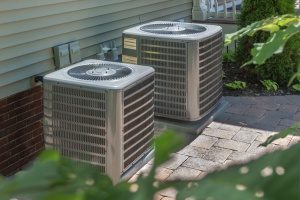Presidential Heating & Air Conditioning
Gaithersburg HVAC Contractors
Share
Share on FacebookTweet
Tweet this0Share
Share on LinkedIn0 shares on LinkedIn Thermostat problems can be obvious – perhaps yours is a newer electronic model and it only gives you a blank screen or an error message, or it is frozen on a setting. On the other hand, a malfunctioning thermostat, whether new or old, may not be so easy to diagnose. It can cause you to think something is wrong with the air conditioner equipment itself and that you will need an AC repair. For example, you may notice that the system does not come on at all. If it does come on it runs for longer periods than normal, and you may have to turn it off manually.
Thermostat problems can be obvious – perhaps yours is a newer electronic model and it only gives you a blank screen or an error message, or it is frozen on a setting. On the other hand, a malfunctioning thermostat, whether new or old, may not be so easy to diagnose. It can cause you to think something is wrong with the air conditioner equipment itself and that you will need an AC repair. For example, you may notice that the system does not come on at all. If it does come on it runs for longer periods than normal, and you may have to turn it off manually.
Before you conclude that the problem is in your air conditioning, make sure the thermostat is not the culprit. If you have an older thermostat, you should replace it with a newer digital one even if the old one is still working. The older thermostats are not efficient, and the digital models do a much better job of controlling the room temperature. When you decide to replace it, make sure you buy a thermostat that is compatible with your HVAC system. It is best to replace your thermostat after an AC repair or replacement. Call a professional HVAC technician and get expert information about what kind of thermostat to buy for your system.
If you are having problems with your thermostat, you can sometimes fix it or replace a bad one yourself, avoiding the expense of an HVAC service call. Here are some things to try before you call in a professional HVAC technician for an AC repair.
1. Make Sure the Thermostat is “On”
This seems like a no-brainer. Make sure the thermostat is set to “on”. Make sure it is set to “cool” or “heat”, as appropriate. Sometimes thermostats get switched off or reset accidentally. Make sure the circuit breaker for the thermostat has not tripped. If the circuit and the thermostat are both on, check the programming to make sure it has not been reprogrammed by another occupant in the home. If it operates with batteries, replace the battery with fresh ones.
Some Honeywell and other brands’ programmable thermostats show a blank screen when there is no power to the wall unit. If you are experiencing that, try replacing the batteries with new ones.
If you are certain the breaker has not tripped and the batteries are new, you may have a problem with the wiring. Corrosion, or loose wiring or loose screws, can affect the proper functioning of the thermostat. These repairs usually require an experienced handyman or a professional HVAC technician to resolve.
2. Remove the Thermostat Cover and Clean Out Any Debris
Dirty thermostat components can cause the system not to go on, or once on not to turn off. If your air conditioner will not go on or turn off automatically at the programmed temperature, try cleaning out the inside of the thermostat. Turn the power off to the thermostat. Carefully remove the cover and gently remove any dust, spider webs, or debris with a soft cloth or a puff of air. Avoid rough handling of the sensitive components of the thermostat. Replace the cover.
3. Determine if the Thermostat is Sending Any Signal
Set the thermostat to cool. Have a helper stand near the air conditioner. You stand by the thermostat. Slowly lower the thermostat setting to five degrees below the room temperature. The air conditioner should make a sound when it receives the signal from the thermostat. The thermostat will also make a clicking noise, indicating that it is working properly. If there is no sound, you know the thermostat or the wiring is bad and needs to be replaced.
4. Determine if the Thermostat is Operating Efficiently
Once you are certain the thermostat is getting power, you can easily ascertain whether it is keeping the room at the correct temperature. Tape a regular thermometer to the wall near the thermostat. Place a folded paper towel between the thermometer and the wall to prevent temperature transfer from the wall to the thermometer. Wait at least 15 minutes, and then compare the thermometer reading to the thermostat reading. It should be no more than one degree different. If the difference exceeds one degree, you probably have a faulty thermostat.
Contact a Professional HVAC Technician for Assistance
If you have tried these measures and you’re still experiencing thermostat or air conditioning issues, call a reputable HVAC technician for help. The technician may be able to offer you some other easy DIY techniques to help you avoid the expense of a service call. If a visit to your home is necessary and a malfunctioning thermostat is the problem, be comforted knowing that a faulty thermostat is less expensive to resolve than a malfunctioning air conditioning system. The service technician can also conduct an AC repair or replacement, so you know that your new one is the right one for your HVAC system.


